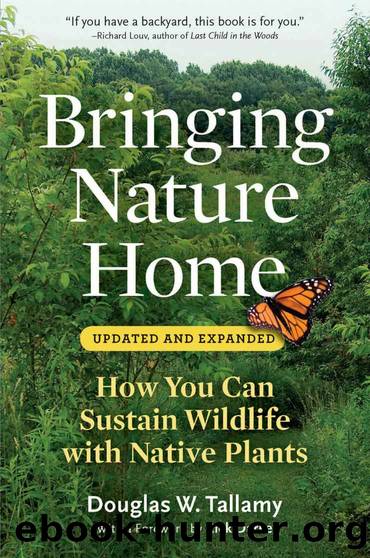Bringing Nature Home: How You Can Sustain Wildlife With Native Plants by Douglas W. Tallamy

Author:Douglas W. Tallamy [Tallamy, Douglas W.]
Language: eng
Format: epub
Tags: Non Fiction, Non-Fiction, Gardening, Garden, Environment, Environmental, Nature, Science, Ecology, Sustainable Living, Sustainability, Biology, Plants
ISBN: 9780881929928
Google: szK9uNKvTkQC
Amazon: 0881929921
Goodreads: 2227735
Publisher: Timber Press
Published: 2009-04-02T04:00:00+00:00
HAWTHORNS
Family Rosaceae, genus Crataegus
Number of species in North America: Many
The genus Crataegus is large and taxonomically confusing. Only a few experts in the world are capable of identifying most species with confidence, and even they canât agree on how many species there are in North America. Estimates range from 200 to 1000. Even if the minimum estimate turns out to be accurate, Crataegus is one of the largest genera of woody plants in the world. Like oaks, hawthorns hybridize regularly, making their identification even more challenging. All species are small trees, with many of the features that we like on crabapples (beautiful spring flowers, striking red fruits in the fall), although most species present stiff thorns up to two inches in length on their branches. When planted in full sun, their fruits can be numerous and provide nice red accents through the first several months of fall and winter.
Because of their copious fruit production, hawthorns provide food for birds and mammals alike. Their thorny branches are safe nesting sites for many bird species, and their leaves nourish 159 species of eastern caterpillars. Because hawthorns are close relatives of crabapples and cherries, they host many of the same species of Lepidoptera, including 5 sphinx moths, 10 dagger moths, and 6 butterflies. One species found on hawthorn illustrates the lengths to which some caterpillars will go to hide from birds. The blinded sphinx (Paonias excaecatus), snips the remains of each leaf as it eats it from the tree, thereby removing one of the primary cues birds use to locate caterpillars among the foliage.
Download
This site does not store any files on its server. We only index and link to content provided by other sites. Please contact the content providers to delete copyright contents if any and email us, we'll remove relevant links or contents immediately.
Turbulence by E. J. Noyes(7058)
The Thirst by Nesbo Jo(5793)
Gerald's Game by Stephen King(3927)
Be in a Treehouse by Pete Nelson(3234)
Marijuana Grower's Handbook by Ed Rosenthal(3126)
The Sprouting Book by Ann Wigmore(3056)
The Red Files by Lee Winter(2923)
The Remains of the Day by Kazuo Ishiguro(2627)
Sharp Objects: A Novel by Gillian Flynn(2451)
Christian (The Protectors Book 1) by L. Ann Marie(2396)
Organic Mushroom Farming and Mycoremediation by Tradd Cotter(2314)
The Culinary Herbal by Susan Belsinger(2063)
Stone Building by Kevin Gardner(1998)
The Starter Garden Handbook by Alice Mary Alvrez(1930)
Lilac Girls by Martha Hall Kelly(1883)
The Unlikely Pilgrimage of Harold Fry by Rachel Joyce(1838)
The Lean Farm Guide to Growing Vegetables: More In-Depth Lean Techniques for Efficient Organic Production by Ben Hartman(1789)
Urban Farming by Thomas Fox(1752)
Backyard Woodland by Josh VanBrakle(1591)
